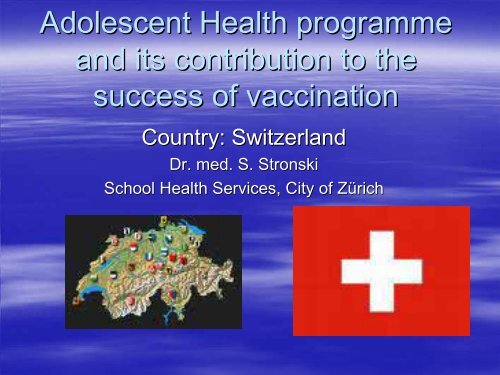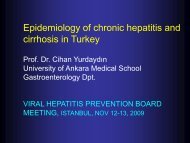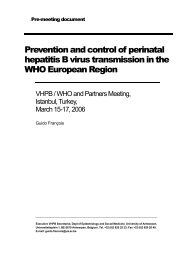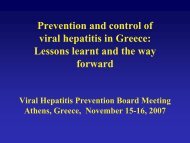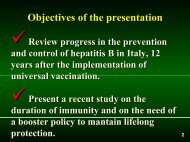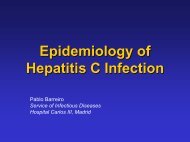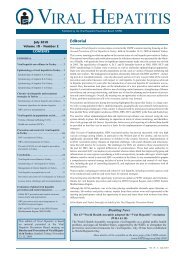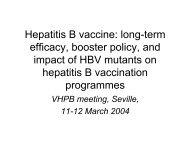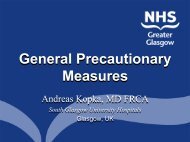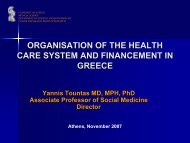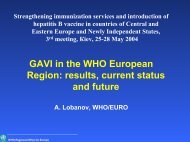Adolescent health programme and its contribution to the success of ...
Adolescent health programme and its contribution to the success of ...
Adolescent health programme and its contribution to the success of ...
You also want an ePaper? Increase the reach of your titles
YUMPU automatically turns print PDFs into web optimized ePapers that Google loves.
<strong>Adolescent</strong> Health <strong>programme</strong><br />
<strong>and</strong> <strong>its</strong> <strong>contribution</strong> <strong>to</strong> <strong>the</strong><br />
<strong>success</strong> <strong>of</strong> vaccination<br />
Country: Switzerl<strong>and</strong><br />
Dr. med. S. Stronski<br />
School Health Services, City <strong>of</strong> Zürich
1) Childhood vaccination schedule:<br />
Age<br />
DTaP<br />
IPV<br />
HIB<br />
Hep B<br />
MMR<br />
dT<br />
(see<br />
DTap)<br />
Varicella<br />
TBE<br />
If<br />
endemi<br />
c<br />
(Meningoco<br />
ccal<br />
Disease) 2<br />
2 months(1) x X x<br />
3 months<br />
4 months x X x<br />
6 months x x x<br />
12-15 15 months x X 3<br />
15-24 months x x x X 1<br />
4-7years<br />
x x Starting<br />
at age<br />
six (3<br />
doses)<br />
11-15<br />
15 dTp<br />
2 doses (2 doses<br />
if neg.<br />
his<strong>to</strong>ry)<br />
[1: catch-up vaccination recommended any time<br />
2: Vaccination against Meningococci Type C: additionally recommended<br />
for those wishing it. 3: catch-up till age 5years.<br />
Additionally recommended Pneumococci: 2,4,12 months<br />
Vaccination plan:<br />
www.ekif.ch<br />
x
2.1) How are <strong>the</strong><br />
children/adolescents reached<br />
School medicine system.<br />
• No nationwide system. Each can<strong>to</strong>n (state,<br />
n=26) has <strong>its</strong> own system.<br />
• School Health Services are based on can<strong>to</strong>nal<br />
<strong>health</strong> <strong>and</strong> education law. Responsibility for<br />
organisation <strong>of</strong> services at level <strong>of</strong> community.<br />
• 16/26 can<strong>to</strong>ns (62%) <strong>of</strong>fer Hep B vaccination in<br />
schools*.<br />
• Pro<strong>of</strong> <strong>of</strong> better vaccination rates, where school<br />
<strong>health</strong> services are available <strong>and</strong> <strong>of</strong>fering<br />
vaccinations*.<br />
*Masserey V, 2004
2.2) How are <strong>the</strong><br />
children/adolescents reached O<strong>the</strong>r<br />
channels<br />
• Childhood: Vaccination mainly based on<br />
private sec<strong>to</strong>r. Most children are reached<br />
by pediatricians <strong>and</strong> general practitioners.<br />
• Adolescence: private sec<strong>to</strong>r <strong>of</strong>fers<br />
vaccination, many adolescents do not visit<br />
doc<strong>to</strong>rs for preventive vis<strong>its</strong>.
3) Who are <strong>the</strong> vaccina<strong>to</strong>rs<br />
• Vaccina<strong>to</strong>r is defined by local practice:<br />
doc<strong>to</strong>r/ nurse, physician assistant.
4) Training <strong>of</strong> <strong>the</strong> vaccina<strong>to</strong>rs<br />
• Physicians<br />
– Undergraduate Level: Knowlegde <strong>and</strong> skills in<br />
vaccinations defined as objective for training<br />
– Postgraduate level: in depth training defined<br />
e.g. in pediatric curriculum, GP-curriculum<br />
– CME: national meeting on vaccination 1x/2<br />
years<br />
• Nurse/ Physician assistant:<br />
– part <strong>of</strong> training,<br />
– In service training e.g. in school <strong>health</strong> service
5) Financing <strong>of</strong> child <strong>and</strong><br />
adolescent vaccination<br />
• All vaccines mentioned are nationwide<br />
• covered by <strong>the</strong> <strong>health</strong> insurances.<br />
• Part <strong>of</strong> <strong>the</strong> fee (10%) for consultation<br />
necessary for <strong>the</strong> vaccination has <strong>to</strong> be paid<br />
by patient.<br />
• School Health Services usually <strong>of</strong>fer<br />
vaccinations for free <strong>and</strong> ei<strong>the</strong>r get globally<br />
reimbursed by <strong>health</strong> insurance or have <strong>to</strong><br />
bill insurance for every patient.
6) Decisions on introduction <strong>of</strong><br />
new vaccines<br />
• A federal commission (www.ekif.ch(<br />
www.ekif.ch) ) <strong>of</strong> experts<br />
decide on <strong>the</strong> vaccination schedule. Two levels <strong>of</strong><br />
recommendations: “for all”, “additionally<br />
recommended”.<br />
• Coverage by <strong>health</strong> insurances usually follow<br />
recommendations <strong>of</strong> commission. Sometimes no<br />
coverage for “additionally recommended” vaccines.<br />
• School Health Services <strong>of</strong>ten need positive decision<br />
<strong>of</strong> Can<strong>to</strong>nal (State) Department <strong>of</strong> Health <strong>to</strong> put a<br />
vaccine on list <strong>of</strong> vaccines <strong>of</strong>fered for School Health<br />
Care.
Challenges <strong>to</strong> introduce<br />
new/additional vaccines for<br />
adolescents (1)<br />
• Recommendation by federal commission<br />
• Coverage by <strong>health</strong> insurance<br />
• Decision <strong>of</strong> State Health Department <strong>to</strong> put vaccine on<br />
list for School Health Services<br />
• Convincing/educating vaccina<strong>to</strong>rs about necessity <strong>of</strong><br />
immunization<br />
• Reaching adolescent population, identifying<br />
opportunities for vaccination (e.g. gynecological<br />
consultation)
Challenges <strong>to</strong> introduce<br />
new/additional vaccines for<br />
adolescents (2)<br />
• Parental acceptance <strong>of</strong> vaccination<br />
• Fears regarding proven <strong>and</strong> unproven<br />
<strong>health</strong> effects <strong>of</strong> vaccines, supported<br />
by widely distributed publications <strong>of</strong><br />
“anti-vaccination<br />
vaccination-experts”<br />
• Lack <strong>of</strong> knowledge <strong>of</strong> providers about<br />
adolescent capacity <strong>to</strong> decide for<br />
vaccination
Challenges (3):<br />
Minors right <strong>to</strong> decide for a vaccination:<br />
• Request <strong>to</strong> <strong>the</strong> Federal<br />
Office <strong>of</strong> Health <strong>to</strong> clarify<br />
question <strong>of</strong> minor‘s right.<br />
• Clear position: Minor with<br />
decisional capacity can<br />
request vaccination<br />
without parental consent.<br />
• Decisional capacity for<br />
vaccination can be<br />
assumed by default at<br />
about age 15, before this<br />
age provider has <strong>to</strong><br />
assess <strong>and</strong> document this<br />
capacity.<br />
• Reality: Example<br />
City <strong>of</strong> Zürich:<br />
Based on state<br />
(can<strong>to</strong>nal)<br />
educational law,<br />
this right for minors<br />
is denied. . Same in<br />
most School Health<br />
Services.<br />
Discussion<br />
ongoing.
7) Coverage data<br />
• No nationwide population data regarding<br />
immunization rates<br />
• Basis is established for a moni<strong>to</strong>ring based<br />
on a national sample drawn all 3 years.<br />
Participation rate 2005: 80%.<br />
• No published national data on vaccina<strong>to</strong>rs.
Institute <strong>of</strong> Social <strong>and</strong><br />
Preventive Medicine<br />
Zürich 2005, Lang PH<br />
2007<br />
Vaccination<br />
Rate<br />
Children at<br />
age 3 years
Institute <strong>of</strong> Social <strong>and</strong><br />
Preventive Medicine<br />
Zürich 2005, Lang Ph<br />
2007<br />
Vaccination<br />
Rates<br />
School-age<br />
Children 7-9<br />
years
Institute <strong>of</strong> Social <strong>and</strong><br />
Preventive Medicine<br />
Zürich 2005, Lang Ph<br />
2007<br />
Vaccination<br />
Rate<br />
Youth<br />
(13-16<br />
16<br />
years)
Immunization Rates Hepatitis B, Zürich<br />
before <strong>and</strong> after intervention <strong>of</strong> School Health<br />
Service<br />
Swiss Citiziens (CH) versus Non-Swiss<br />
Citizens (N-CH)<br />
Percentage <strong>of</strong> Students with one or more<br />
documented Hep.B. immunizations<br />
%<br />
100<br />
80<br />
60<br />
40<br />
20<br />
0<br />
CH<br />
99/00<br />
N-CH<br />
99/00<br />
CH<br />
02/03<br />
N-CH<br />
02/03<br />
before SHS<br />
after SHS<br />
99/00: n=2150<br />
age 14.4 (+/-1.48)<br />
02/03: n=1832<br />
age 14.7 (+/-1.53)<br />
Stronski, Takken, Christen, 2004
Masserey 2004
Masserey 2004
8) Strengths <strong>of</strong> <strong>the</strong> immunization<br />
• Private sec<strong>to</strong>r:<br />
<strong>programme</strong>s<br />
– Well established private sec<strong>to</strong>r <strong>of</strong>fers<br />
recommended preventive vis<strong>its</strong>, scheduled<br />
according <strong>to</strong> vaccination plan.<br />
– While compliance is good for preventive vis<strong>its</strong> in<br />
younger children, parents <strong>of</strong> school children<br />
<strong>of</strong>ten do not actively seek preventive care.<br />
– Private sec<strong>to</strong>r does not outreach.
8) Strengths <strong>of</strong> <strong>the</strong> immunization<br />
<strong>programme</strong>s<br />
• School Health system<br />
– reaches good immunization rates at lower<br />
cost as private sec<strong>to</strong>r.<br />
– Possibility <strong>to</strong> use school lessons for<br />
information on vaccines as well as peer<br />
effects add <strong>to</strong> increase vaccination rate.
9) Challenges <strong>of</strong> <strong>the</strong><br />
immunization <strong>programme</strong>s<br />
• Private sec<strong>to</strong>r does not reach adequately <strong>the</strong> population <strong>of</strong><br />
school children <strong>and</strong> even less adolescents.<br />
• School Health Services<br />
– are not well established in many parts <strong>of</strong> <strong>the</strong> country,<br />
– not all <strong>of</strong> <strong>the</strong>m are involved in vaccination.<br />
– Future <strong>of</strong> School Health Services hampered by change <strong>of</strong><br />
legal framework increasingly transferring vaccinations <strong>to</strong><br />
private sec<strong>to</strong>r.<br />
– Sometimes extended time <strong>to</strong> realize new vaccination or <strong>to</strong><br />
react <strong>to</strong> new evidence (e.g. better vaccine with less side<br />
effects) due <strong>to</strong> slow administrative procedures.<br />
– Private sec<strong>to</strong>r arguments: Lack <strong>of</strong> continuity <strong>of</strong> care.
10) Conclusions<br />
• While coverage <strong>of</strong> <strong>the</strong> cost <strong>of</strong> vaccinations by <strong>the</strong><br />
<strong>health</strong> insurances <strong>and</strong> a well established private<br />
sec<strong>to</strong>r achieve good immunization rates in<br />
preschool children, <strong>the</strong>re are still no sufficient<br />
immunization rates for school-age children <strong>and</strong><br />
adolescents.<br />
• School Health Services significantly improve <strong>the</strong>se<br />
vaccination rates, however school <strong>health</strong> services<br />
are not established nationwide.


